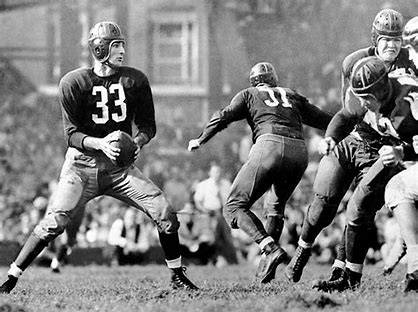When it comes to the greatest coaches of all time, there are names like Bill Belichick, Mike Ditka, Tom Landry & Bill Walsh. However, a name that’s gotten skipped over is one of the most dominant coaches of the 1970s, Chuck Noll. The man who helped build the Steel Curtain and was a part of all six of the Pittsburgh Steelers Super Bowl winning teams as a coach & administrator. Here’s a look back at the life & legacy of the architect of the Steel Curtain, and the catalyst of the Steelers’ run of dominance for more than forty years, Chuck Noll.
Early Life & Collegiate Career
Charles Henry Noll was born on January 5, 1932 in Cleveland, Ohio as the youngest of three children. His father was unable to work due to Parkinson’s, and his mother was a florist. Noll grew up near East 74th Street, a neighborhood with a large African American population. That helped Noll’s championship of providing African American opportunities in the NFL. Noll attended Benedictine High School, a private all-boys Catholic school in Cleveland. He played running back and tackle and earned All-State honors. As a freshman in college, Noll planned on playing at Notre Dame. Before the year started, Noll suffered an epileptic seizure, and coach Frank Leahy refused to risk playing Noll. Chuck rebounded at the University of Dayton, where he played as a lineman and a linebacker. He was a co-captain while at Dayton, and he graduated with a degree in secondary education.
Cleveland Brown
Noll was picked 239th overall in the 1953 NFL Draft to his hometown Cleveland Browns, where he played as a guard and linebacker. In his first season, the Browns lost to the Lions in the NFL Championship game. Noll was an undersized guard, but he was used to help send play calls to Otto Graham. Noll only made around $5000 a season, and he also worked as a substitute teacher at Holy Name High School in Parma Heights, Ohio. He also went to the Cleveland-Marshall School of Law, but chose against being a lawyer because he hated the confrontation and arguments that came with it. After losing his starting spot at guard to John Wooten, Noll retired as a player at the age of 27, and was almost immediately hired to be a defensive line coach for the Los Angeles Chargers in the AFL.
LA/San Diego Chargers & Colts
Chuck Noll is considered to be part of Sid Gillman’s coaching tree alongside the legendary Al David. In 1960, Noll was hired to be the defensive line coach for the Chargers, then moved up to be their defensive coordinator in 1962, a position he would hold until 1965. Sid Gillman remembered Noll as an offensive specialist, and someone who the players loved. In 1966, Noll went to the Baltimore Colts where he served alongside the legendary Don Shula as their defensive coordinator. Noll’s first trip to the Super Bowl was in Super Bowl III, where his Colts infamously lost to ‘Broadway’ Joe Namath, the most overrated quarterback to stumble his way into the Hall of Fame besides George Blanda.
The Steel Curtain
Noll was hired on January 27, 1969 to become the 14th head coach for the Pittsburgh Steelers, a job that Joe Paterno turned down. Art Rooney credited Shula for recommending Noll for the job, and at the time he was the youngest head coach in NFL History at the age of 36. Noll’s coaching style earned him the nickname Emperor Chaz by legendary radio announcer Myron Cope. He also implemented a defensive system that soon gave rise to the Steel Curtain, arguably the greatest defensive unit in NFL History. The secret to their success was unbelievably great drafting. His first pick in the Steel City, was a guy from North Texas by the name of Joe Greene, the anchor of the Steel Curtain and one of the greatest defensive players in the history of the game. However, the Steelers went 1-13 in his first year, and they had the top draft pick. He selected current FOX analyst and LA Tech standout Terry Bradshaw with the top pick. In the third round that year, the Steelers drafted Mel Blount, arguably the most violent DB in NFL History. After a couple more of mediocre seasons, the Steelers selected Penn State running back Franco Harris in 1972, and the Steelers went to the AFC Championship game, losing to the undefeated Dolphins. Also in the 1972 postseason, the Steelers’ legendary rivalry with the Oakland Raiders began thanks to the Immaculate Reception. In 1973, the Steelers lost to the Raiders in the divisional round. Then came what may be the greatest draft any team has had in a given year. With four of their first five draft picks, the Steelers drafted John Stallworth, Lynn Swann, Mike Webster, and Jack Lambert. All four of those men are in the Pro Football Hall of Fame. With this core in place, the Steelers went 10-3-1 and defeated the Minnesota Vikings 16-6 in Super Bowl IX. The next year, the Steelers went 12-2 and successfully repeated, winning Super Bowl X against Tom Landry’s Cowboys 21-17. In 1976, the Steelers boasted one of the strongest defensive performances ever, surrendering only 9.8 points per game and five shutouts. They lost to the Raiders in the AFC Championship game, robbing them of a potential three-peat. In 1978, the Steelers went back to the Super Bowl, defeating the Cowboys in a high scoring affair, 35-31. Noll won his fourth title the next year against the Vikings. Noll became the first, and one of two coaches to have won four Super Bowls. After a couple of years of not making the playoffs, the Steelers kicked off the eighties with playoff losses to the Chargers in the Wild Card, the Raiders in the divisional round, and Miami in the 84 AFC Championship. 1984 was the last time the Steelers won the division under Noll’s tenure as head coach, and they would make the playoffs in 1988, and they lost to the Broncos in the divisional round. After the 1990 season, Noll retired as the head coach of the Pittsburgh Steelers. He had a coaching record of 193-148-1, and a 16-8 postseason record. To this day, Noll remains the only coach in NFL History to go 4-0 in the Super Bowl.
Later Years
Noll would remain with the Steelers as the ceremonial Administrative Advisor, but had no real role in the team operations, and he would serve that role until 2013. In 1993, Noll was inducted into the Pro Football Hall of Fame alongside Bill Walsh, Larry Little, Walter Payton & Dan Fouts. He suffered from chronic back problems that limited his mobility, and he spent most of his time in Florida or his suburban home in Pittsburgh. On June 3, 2014, Chuck Noll passed away after struggling with Alzheimer’s and various other health problems.
Legacy
As I stated earlier, Chuck Noll is often overlooked when it comes to naming the greatest coaches, which is shocking considering the success he’s had in the 1970s. He is one of two coaches to have won four Super Bowl championships, and the only one to win four Super Bowls in a decade. I don’t know why it is that Noll doesn’t get the proper reverence he deserves. Maybe it’s because he was part of perhaps the greatest era of coaches in NFL History, with many Hall of Fame coaches during that time including Tom Landry, Bill Walsh, Joe Gibbs, Bill Parcells, Don Shula, Mike Ditka, and others. In the Steel City, Noll set a herculean standard for their coaches, as well as unbelievable job security. In fifty one years, the Steelers have only had three head coaches, Noll, Bill Cowher, and Mike Tomlin. Although those are three hall of fame coaches, Noll stands head and shoulders above the rest, owning a majority of Steelers coaching records including wins, championships, and playoff wins. Now I’ll pose you a couple of questions: First, where does Noll stand among the all-time greats, and secondly, do you think he has the proper respect?


